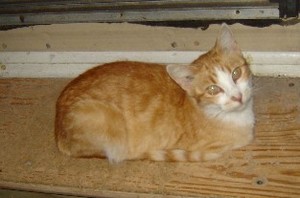I don’t know what took me so long to think of helping at our local animal shelter. I love cats; I have always wanted to work at a pet shelter; there are several of them here in the area, and I’ve got some time on my hands – yet, for years it hadn’t occurred to me to put all these together and volunteer. I suppose a part of the reason and my only valid excuse is the fact that I don’t drive, which, as we all know, here in America equals to being under house arrest. An introvert and a bookworm, I don’t mind it most of the time, but once in a while even I get frustrated and vow to get rich and hire myself a chauffeur (yeah, right).
Anyway, when I finally made up my mind to try it I had contacted the Just Animals Shelter (Seneca, IL) and asked whether they needed volunteers to help with cats. They promptly replied that they did, very much. So there I was on a Friday morning, around 9:00 a.m., ready to give my love to the kitties. It was a blessing from the beginning and to the end, so much so that I decided to write it all down and share it with other animal lovers.
The shelter is small but very efficient, with everyone knowing their work and all the necessary supplies ready at hand. I was warmly greeted by other volunteers (it is a volunteer-based shelter with no paid employees), explained how to clean the cages, and within minutes I was already busy, doing the job of my dreams.
The process is simple. Each cat has an individual cage where they spend the night, with their own food & water bowls, bedding, a litter box and maybe some toys. You open the cage and take everything out, then you vacuum the cage floor. After that you wipe the floor with a sponge with disinfectant. The litter box gets cleaned next and put back into the cage. Then food and water bowls are refilled and put back in, and then the bed, if it’s clean enough; soiled bedding goes into the laundry pile and is replaced by a clean one. Fascinating, isn’t it?!
I began with enthusiasm, reading each kitty’s name off of the cage tag and talking to them as I worked. I could see right away that they didn’t really care so much for food and other maintenance routine as they craved fellowship and attention. Almost each kitty wanted to communicate and longed to be petted. Just let me finish with the cleanup,” I thought, “then we’ll have some quality time.” Socializing shelter animals is just as important, if not more, than taking care of their physical needs, and that was the part of the job I was especially looking forward to.
Meanwhile, I was going from cage to cage, cleaning, closely followed by a small calico who appeared to be fascinated with the vacuum cleaner – or perhaps thought it her duty to inspect the work of the new volunteer. She would sit down at the cage door and look, turning her head after the movements of the vacuum in the funniest manner. I learned later on that this friendly girl had been adopted from the shelter as a kitten, and then found roaming the streets as an adult cat. She was rescued by Animal Control and brought back to the shelter, thanks to the microchip (all of the shelter animals are microchipped). The ex-owner refuses to take phone calls from the shelter, so the little calico is up for adoption again. Unfortunately, stories like this are not rare.
Several other cats were out of the cages as well, so I had to watch my step. One I had soon nicknamed Mr. Mischief – a skinny black & white male with beautiful yellow eyes. Mr. Mischief was everywhere at once, running, chasing toys and jumping at the water bucket. I first thought that his bumps into the bucket were accidental, caused by excitement and excess energy. I was wrong. Mr. Mischief’s purpose was to knock the bucket over, which he successfully accomplished within a short time, flooding half the room. His cunning expression as he watched another volunteer gather the spilled water with towels left no doubt that it was planned entertainment.
In one of the last several cages I had to do was a shy orange & white girl named Lucy. Lucy looked at me with large eyes and acted a little frightened of the vacuum cleaner. I prompted her to come out of the cage while I worked on it, but she wouldn’t. I then tried to get done with the vacuuming as fast as I could, reassuringly talking to her all the time. Lucy listened. When I was done, I had to move her a little aside to put the bedding back in. She didn’t mind being touched, but still looked stressed. I decided to pet her some more. The decision turned out to be a bad one: on the second stroke along her back Lucy suddenly turned her head and bit my hand. That came as a big surprise. I know cats, and I know their warning signs; Lucy gave none. I guess the bite itself was a warning as it was not very strong, but her teeth did leave a mark.
It happens. I suppose every volunteer should be ready for a bite or scratch, especially in the beginning when cats do not yet know them. Sometimes cats misread our intentions, and we misread their mood. Even now as I look back I don’t think I made a mistake or did something to provoke Lucy. Her letting me move her while I was replacing the bed showed that she was not in an aggressive mood, but apparently she was not ready for more contact.
When we were done cleaning the cages and refilling food and water bowls, we let the kitties out to run and play in the room. My favorite part of the work had begun: getting to know the cats, petting them, combing, etc. As I already mentioned, socializing shelter animals is even more important than taking care of their physical needs – not only because they simply need love but also because it helps to ensure successful adoptions. Some people do not have the patience needed to deal with a shy animal and earn its trust. If a cat hides in the new home and acts frightened of the new owners, chances are such a cat will be returned to the shelter. That’s why volunteers are doing their best to socialize the cats.
I had several cats in mind that I especially liked from the start, so I began with them. One, named Nixon, was a tuxedo-wearing gentleman and the biggest cat in the shelter. I have a soft spot for big cats, I admit. I sat down next to Nixon and called him by name. He immediately followed my invitation, jumping onto my lap. A gentle giant,” I thought, and I turned out to be right. As I combed and petted the happily purring Nixon, I asked for his story. Nixon used to be a stray, I was told. He was brought to the shelter scrawny and ill, covered with machine oil. It took him a while to become the bodybuilder he was now. I couldn’t believe it when I was told that Nixon had been adopted and then returned: the new owners did not like him. What could they possibly not like in such a wonderful boy??
Two other cats that had gotten my attention were two brothers, Garfield and Guss – two beautiful, large orange tabbies. These boys used to have a home, and were even declawed. Their owner had given them up when she had to move after the death of her husband. Now, cats surrendered from homes are those I especially feel for. Strays rescued from the streets do not know any better life and adjust to the shelter quickly enough: they see that people are taking care of them, and they are happy. But cats who used to have a family suffer a lot. They miss their home and family and all the attention they used to get. As hard as the volunteers try, it is simply not possible to love and cuddle every one of 50+ cats as your own pet. I played with Garfield and Guss for a while. They responded with mild interest; I could see that they were sad, and that the sadness would probably go away soon enough if they were taken into a home.
More toys were brought. I picked a teasing wand with some feathers on the end and waved it above the floor: “Who wants to play?” The kitties ran to me from all directions, all excited. However, most were soon forced to back off and give way to The Gang: a group who thought they were the only ones entitled to play and would whack everyone else. The group consisted of a young Russian blue called Blueberry, orange and white Magoo, and, of course, Mr. Mischief (see above). My attempts to restrain The Gang and let others play as well were not very successful. Eventually, I found a solution in throwing rubber balls to the other end of the room for The Gang, and while The Gang was busy chasing them I could give some attention to others.
A phone call came in the afternoon, from a family that had taken an older cat for an overnight visit, to see if they liked her. I had noticed an empty cage before, and laughed at the note pinned to the door: “Gone to stay overnight with a possible new family, wish me luck, Peony.” The phone call brought good news: the couple loved Peony and decided to keep her. I never met Peony, but I was so happy for her. Senior cats are difficult to find families for, and Peony, I was told, was such a sweet-natured girl.
On this happy note my first day of helping at the shelter ended. It was after 1:00 PM, time when volunteer work is over. Needless to say, I didn’t want to go home, and couldn’t wait to come again next week. If you are an animal lover thinking about possibly volunteering at your local animal shelter, my advice to you is, GO AHEAD!! You will love it.





